电子产品环境试验简介68页PPT
- 格式:ppt
- 大小:5.04 MB
- 文档页数:68
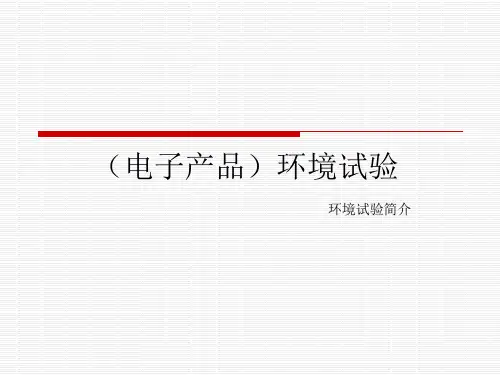

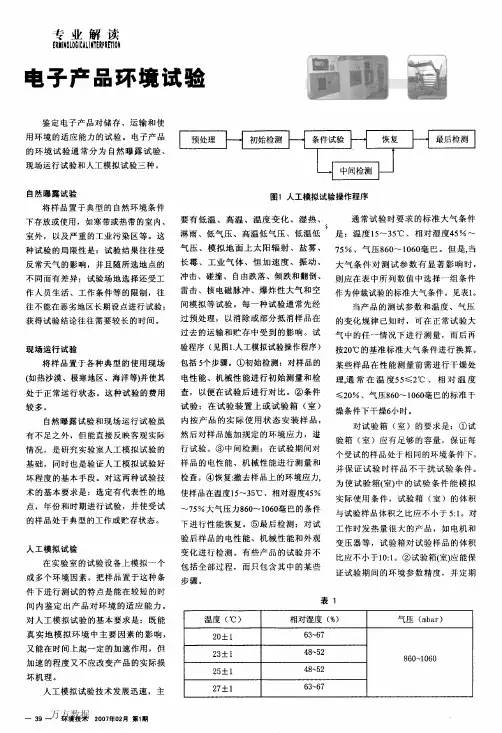
![[课件]医用电器环境要求及试验方法学习PPT](https://uimg.taocdn.com/989b91aa680203d8ce2f249a.webp)
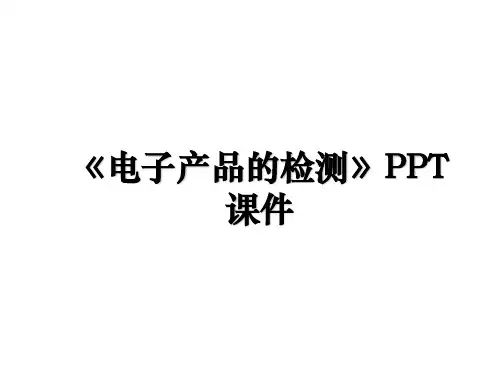
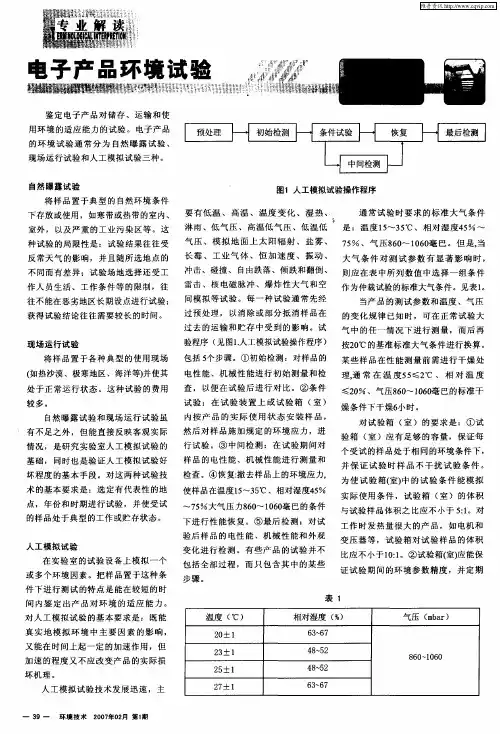
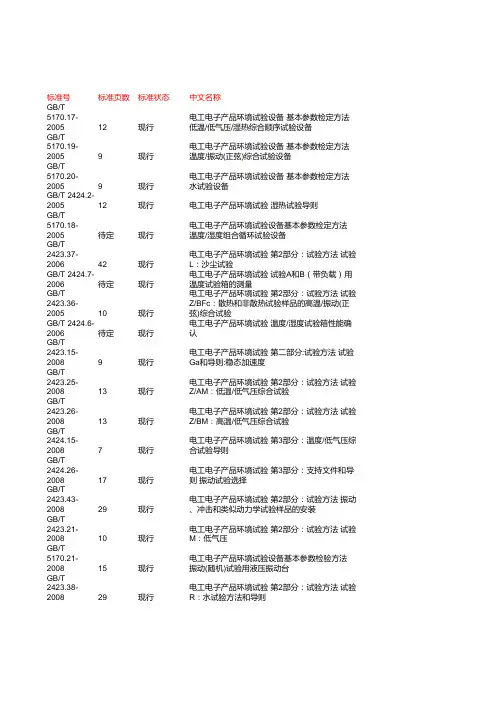
标准号标准页数标准状态中文名称GB/T5170.17-200512现行电工电子产品环境试验设备基本参数检定方法低温/低气压/湿热综合顺序试验设备GB/T5170.19-20059现行电工电子产品环境试验设备基本参数检定方法温度/振动(正弦)综合试验设备GB/T5170.20-20059现行电工电子产品环境试验设备基本参数检定方法水试验设备GB/T 2424.2-200512现行电工电子产品环境试验湿热试验导则GB/T5170.18-2005待定现行电工电子产品环境试验设备基本参数检定方法温度/湿度组合循环试验设备GB/T2423.37-200642现行电工电子产品环境试验第2部分:试验方法试验L:沙尘试验GB/T 2424.7-2006待定现行电工电子产品环境试验试验A和B(带负载)用温度试验箱的测量GB/T2423.36-200510现行电工电子产品环境试验第2部分:试验方法试验Z/BFc:散热和非散热试验样品的高温/振动(正弦)综合试验GB/T 2424.6-2006待定现行电工电子产品环境试验温度/湿度试验箱性能确认GB/T2423.15-20089现行电工电子产品环境试验第二部分:试验方法试验Ga和导则:稳态加速度GB/T2423.25-200813现行电工电子产品环境试验第2部分:试验方法试验Z/AM:低温/低气压综合试验GB/T2423.26-200813现行电工电子产品环境试验第2部分:试验方法试验Z/BM:高温/低气压综合试验GB/T2424.15-20087现行电工电子产品环境试验第3部分:温度/低气压综合试验导则GB/T2424.26-200817现行电工电子产品环境试验第3部分:支持文件和导则振动试验选择GB/T2423.43-200829现行电工电子产品环境试验第2部分:试验方法振动、冲击和类似动力学试验样品的安装GB/T2423.21-200810现行电工电子产品环境试验第2部分:试验方法试验M:低气压GB/T5170.21-200815现行电工电子产品环境试验设备基本参数检验方法振动(随机)试验用液压振动台GB/T2423.38-200829现行电工电子产品环境试验第2部分:试验方法试验R:水试验方法和导则GB/T 2423.4-200812现行电工电子产品环境试验第2部分:试验方法试验Db 交变湿热(12h+12h循环)GB/T 2423.2-200815现行电工电子产品环境试验第2部分:试验方法试验B:高温GB/T 2423.1-200815现行电工电子产品环境试验第2部分:试验方法试验A:低温GB/T2423.32-200815现行电工电子产品环境试验第2部分:试验方法试验Ta: 润湿称量法可焊性GB/T 2421.1-200822现行电工电子产品环境试验概述和指南GB/T 2421.2-200884现行电工电子产品环境试验规范编制者用信息试验概要GB/T2423.60-200826现行电工电子产品环境试验第2部分:试验方法试验U:引出端及整体安装件强度GB/T2423.57-200828现行电工电子产品环境试验第2-81部分: 试验方法试验Ei: 冲击冲击响应谱合成GB/T5170.11-2008待定现行电工电子产品环境试验设备检验方法腐蚀气体试验设备GB/T 5170.1-200813现行电工电子产品环境试验设备检验方法总则GB/T5170.10-2008待定现行电工电子产品环境试验设备检验方法高低温低气压试验设备GB/T 5170.5-200816现行电工电子产品环境试验设备检验方法湿热试验设备GB/T 5170.8-200813现行电工电子产品环境试验设备检验方法盐雾试验设备GB/T 5170.9-2008待定现行电工电子产品环境试验设备检验方法太阳辐射试验设备GB/T2423.102-2008待定现行电工电子产品环境试验第2部分:试验方法试验:温度(低温、高温)/低气压/振动(正弦)综合GB/T2423.101-2008待定现行电工电子产品环境试验第2部分:试验方法试验:倾斜和摇摆GB/T2423.48-200824现行电工电子产品环境试验第2部分:试验方法试验Ff:振动-时间历程法GB/T2423.39-200812现行电工电子产品环境试验第2部分:试验方法试验Ee:弹跳GB/T 5170.2-2008待定现行电工电子产品环境试验设备检验方法温度试验设备GB/T2423.59-200816现行电工电子产品环境试验第2部分:试验方法试验Z/ABMFh:温度(低温、高温)/低气压/振动(随机)综合GB/T2424.13-20029现行电工电子产品环境试验第2部分:试验方法温度变化试验导则GB/T2424.19-20058现行电工电子产品环境试验模拟贮存影响的环境试验导则GB/T2423.17-20087现行电工电子产品环境试验第2部分: 试验方法试验Ka:盐雾GB/T2423.18-20008现行电工电子产品环境试验第2部分: 试验试验Kb:盐雾, 交变(氯化钠溶液)GB/T2423.51-200016现行电工电子产品环境试验第2部分:试验方法试验Ke:流动混合气体腐蚀试验GB/T 2423.6-199511现行电工电子产品环境试验第2部分: 试验方法试验Eb和导则:碰撞GB/T 2423.7-19957现行电工电子产品环境试验第2部分: 试验方法试验Ec和导则: 倾跌与翻倒(主要用于设备型样品型)GB/T5170.13-200512现行电工电子产品环境试验设备基本参数检定方法振动(正弦)试验用机械振动台GB/T5170.15-200511现行电工电子产品环境试验设备基本参数检定方法振动(正弦)试验用液压振动台GB/T2423.58-200830现行电工电子产品环境试验第2-80部分: 试验方法试验Fi: 振动混合模式GB/T2423.16-200824现行电工电子产品环境试验第2部分:试验方法试验J及导则:长霉GB/T2424.17-200817现行电工电子产品环境试验第2部分:试验方法试验T:锡焊试验导则英文名称Inspection methods for basic parameters of environmental testing equipments for electric and electronic products--Combined sequential cold low air pressure and damp heat testing equipmentsInspection methods for basic parameters of environmental testing equipments for electric and electronic products --Combined temperature/vibration (sinusoidal) testing equipmentInspection methods for basic parameters of environmental testing equipments for electric and electronic products—Water testing equipmentsEnvironment tests for electric and electronic products-Guidance for damp heat testsInspection methods for basic parameters of environmental testing equipments for electric and electronic products-Composite temperature/humidity cyclic testing equipmentsEnvironmental testing for electric and electronic products—Part 2:Test methods—Test L:Dust and sand Environmental tests for electric and electronic products—Measurements in temperature bhambers for tests A and tests B(with load)Environmental testing for electric and electronic products—Part 2:Test Methods—Test Z/BFc:Combined dryheat/vibration(vibration)(sinusoidal) tests for both heat-dissipating and non-heat-dissipating speciments Environmental testing for electric and electronic products—Confirmation of the performance of temperature/humidity chambersEnvironmental testing for electric and electronic products--Part 2:Test methods--Test Ga and guidance: Acceleration, steadyEnvironmental testing - Part 2: Tests methods - Test Z/AM: Combined cold/low air pressure testsEnvironmental testing - Part 2: Tests methods - Test Z/BM: Combined dry heat/low air pressure testsEnvironmental testing - Guide for combined temperature/low air pressure testsEnvironmental testing - Supporting documentation and guidance - Selecting amongst vibration tests Environmental testing for electric and electronic products - Part 2: Test methods - Mounting of specimens for vibration, impact and similar dynamic testsEnvironmental testing - Part 2: Test methods - Test M: Low air pressureInspection methods for basic parameters of environmental testing equipments - Hydraulic vibrating type machines for vibration(random) testEnvironmental testing for electric and electronic products - Part 2: Test methods - Test R: Water test method and guidanceEnvironmental testing for electric and electronic products - Part 2: Test method - Test Db: Damp heat,cyclic (12h+12h cycle)Environmental testing - Part 2: Test methods - Tests B: Dry heatEnvironmental testing - Part 2: Test methods - Tests A: ColdBasic environmental testing procedures for electric and electronic products--Solderability testing by the wetting balance methodEnvironmental testing - General and guidanceEnvironmental testing - Information for specification writers - Test summariesEnvironmental testing - Part 2: Tests - Test U: Robustness of terminations and integral mounting devices Environmental testing for electric and electronic products - Part 2: Tests - Test Ei: Shock - Shock response spectrum synthesisInspection methods for environmental testing equipments for electric and electronic products - Corrosive gas testing equipmentsInspection methods for environmental testing equipments for electric and electronic products - GeneralInspection methods for environmental testing equipments for electric and electronic products - Combined high and low temperature/low air pressure testing equipmentsInspection methods for environmental testing equipments for electric and electronic products - Damp heat testing equipmentsInspection methods for environmental testing equipments for electric and electronic products - Salt mist testing equipmentsInspection methods for environmental testing equipments for electric and electronic products - Solar radiation testing equipmentsEnvironmental testing for electric and electronic products - Part 2: Test methods - Test: combined temperature(cold and heat)/low air pressure/vibration(sinusoidal)Environmental testing for electric and electronic products - Part 2: Test methods - Test: inclinations and swings Environmental testing for electric and electronic products - Part 2:Test methods - Test Ff: Vibration- Time-history methodEnvironmental testing for electric and electronic products - Part 2: Tests - Test Ee: BounceInspection methods for environmental testing equipments for electric and electronic products - Temperature testing equipmentsEnvironmental testing - Part 2: Test methods - Test Z/ABMFh: Combined temperature(cold and heat)/low air pressure/vibration(random)Environmental testing for electric and electronic products-Part 2:Test methods-Guidance on change of temperature testsEnvironment tests for electric and electronic products-Guidance on the application of the environmental test to simulate the effects of storageEnvrionmental testing for electric and electronic products - Part 2: Test method - Test Ka: Salt mist Environmental testing-Part 2: Tests-Test Kb:Salt mist,cyclic(sodium chloride solution)Environmental testing for electric and electronic products-Part 2:Test methods-Test Ke:Flowing mixed gas corrosion testEnvironmental testing for electric and electronic products. Part 2: Test methods. Test Eb and guidance: Bump Environmental testing for electric and electronic products. Test 2:Test methods. Test Ec and guidance:Drop and topple. Primarily for equipment-type specimensInspection methods for basic parameters of environmental testing equipments for electric and electronic products-Mechanical vibrating type machines for vibration (sinusoidal) testInspection methods for basic parameters of environmental testing equipments for electric and electronic products-Hydraulic vibrating type machines for vibration(sinusoidal) testEnvironmental testing for electric and electronic products - Part 2:Tests -Test Fi: Vibration - Mixed Mode Environmental testing - Part 2: Test methods - Test J and guidance: Mold growthEnvironmental testing - Part 2: Tests methods guidance on - Test T: Soldering Test。
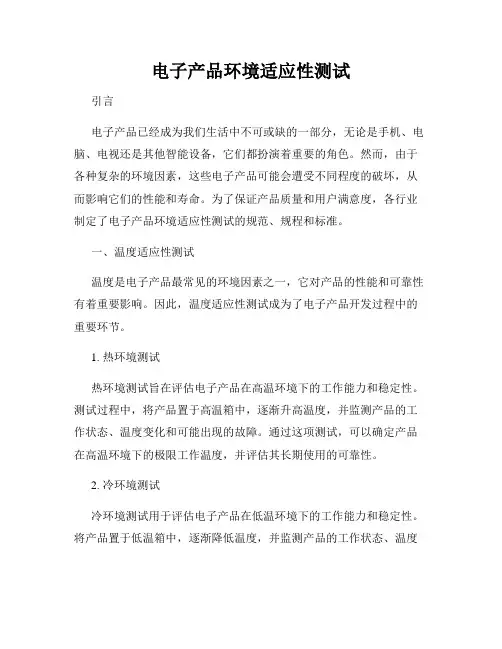
电子产品环境适应性测试引言电子产品已经成为我们生活中不可或缺的一部分,无论是手机、电脑、电视还是其他智能设备,它们都扮演着重要的角色。
然而,由于各种复杂的环境因素,这些电子产品可能会遭受不同程度的破坏,从而影响它们的性能和寿命。
为了保证产品质量和用户满意度,各行业制定了电子产品环境适应性测试的规范、规程和标准。
一、温度适应性测试温度是电子产品最常见的环境因素之一,它对产品的性能和可靠性有着重要影响。
因此,温度适应性测试成为了电子产品开发过程中的重要环节。
1. 热环境测试热环境测试旨在评估电子产品在高温环境下的工作能力和稳定性。
测试过程中,将产品置于高温箱中,逐渐升高温度,并监测产品的工作状态、温度变化和可能出现的故障。
通过这项测试,可以确定产品在高温环境下的极限工作温度,并评估其长期使用的可靠性。
2. 冷环境测试冷环境测试用于评估电子产品在低温环境下的工作能力和稳定性。
将产品置于低温箱中,逐渐降低温度,并监测产品的工作状态、温度变化和可能出现的故障。
通过这项测试,可以确定产品在低温环境下的极限工作温度,并评估其在极寒地区的可靠性。
二、湿度适应性测试湿度是另一个常见的环境因素,对电子产品的性能和寿命有很大影响。
湿度适应性测试旨在评估产品在不同湿度条件下的工作能力和稳定性。
1. 高湿度环境测试高湿度环境测试用于评估产品在高湿度环境下的耐潮湿性能。
将产品置于恒定高湿度环境中,并监测产品的工作状态、温度和湿度变化以及可能出现的故障。
通过这项测试,可以确定产品在高湿度环境中的使用寿命和稳定性。
2. 低湿度环境测试低湿度环境测试用于评估产品在低湿度环境下的耐干燥性能。
将产品置于恒定低湿度环境中,并监测产品的工作状态、温度和湿度变化以及可能出现的故障。
通过这项测试,可以确定产品在低湿度环境中的使用寿命和稳定性。
三、振动与冲击适应性测试振动和冲击是电子产品在运输和使用过程中常遇到的环境因素之一,对产品的性能和可靠性有重要影响。
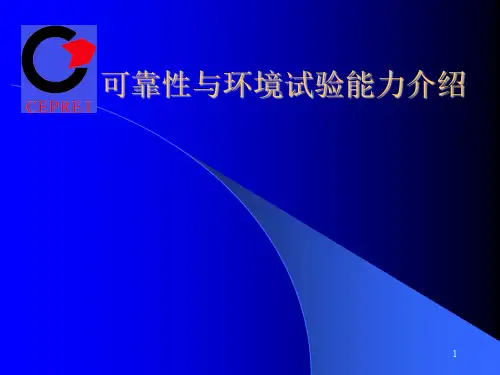


1产品环境可靠性实验(1).测试目的:通过模拟真实的环境条件或再现某效应的方法,以一定的确信度来证实样品在规定环境条件下保持完好和正常工作。
(2)测试条件:a.试验环境为:温度15~35℃;相对湿度45%~75%;大气压力86~106Kpa。
b.各实验条件按各自要求设定。
c.每次测试之后都要求进行恢复,存放1~2H,使产品的温度达到室温,并稳定。
(3).测试内容:a.产品高温工作实验b.产品高温贮存实验c.产品工作温度变化实验d.产品贮存温度变化实验e.产品高低温启动实验f.产品低温工作实验g.产品低温贮存实验h.产品工作恒定湿热实验i.产品贮存恒定湿热实验j.产品老化实验k.产品连续运行实验(4).实验步骤:一般产品的环境可行的测试步骤为:a→b→c→d→f→g→h→i→j→k(5)测试后检验:每次做完条件实验的样品,经过恢复程序后需做以下方面的检验。
a.机械外观检测。
b.综合电气性能检测。
并记录到相关表格上。
c.检测工作应在恢复阶段结束后立即进行。
设备在经过试验后,测试其介电强度、绝缘电阻和电气性能应符合本标准的要求,设备的外观也不应有不良现象出现。
注:现公司无测试整机的温度试验箱,可对小系统进行此项测试,如控制箱+滤波板+通讯显示屏。
3.1产品高温工作实验(1).测试目的:提供一个标准的试验程序,以用来确定产品在高温下工作的适应性。
(2).测试条件:按GB2423.2 “试验Bd”进行。
受试样品须进行初始检测,严酷程度取规定的工作温度上限值40±2℃。
在温度达到规定值时,接通电源满载工作,在额定电压下工作2小时,恢复时间2小时,然后进行最后检测。
(3).测试步骤:a.将处于室温的试验样品按正常位置放入试验箱内,各个产品间要留有间隙,分布要均匀。
b.将试验箱温度调控到试验规定的温度上限40±2℃ ,使试验样品温度达到稳定。
c.当箱内温度达规定值时,对样品加电进行测试记录。
电子科技产品的环境适应性试验研究一、前言随着科技的发展,电子产品已经成为了人们生活中不可缺少的部分。
无论是家用电器、通讯设备还是工业控制系统,都需要面临各种不同的工作环境。
然而电子产品在使用过程中,往往会受到各种因素的干扰,严重影响其稳定性和可靠性,甚至导致损坏或故障。
因此,为了保证电子产品在各种不同的环境下能够正常工作,必须进行环境适应性试验。
本文将简要介绍电子科技产品环境适应性试验的研究和应用。
二、电子科技产品环境适应性试验的概述电子产品在使用过程中会受到各种因素的影响,如温度、湿度、振动、电磁场干扰等。
因此在产品研发和生产前,必须进行各种环境适应性试验,以验证产品的可靠性和稳定性。
环境适应性试验包括低温、高温、温度循环、湿热、盐雾、震动、冲击、跌落、静电、电磁兼容性等试验。
其中,低温和高温试验主要是测试产品在极端温度下的耐受能力;温度循环是测试产品在温度变化过程中的耐受能力;湿热试验是测试产品在高温高湿的环境下的耐受能力;盐雾试验是测试产品在腐蚀环境下的耐受能力;震动、跌落和冲击试验是测试产品在运输、使用过程中的耐受能力;静电和电磁兼容性试验是测试产品对静电和电磁场的耐受能力。
各种环境适应性试验的目的是为了提高产品的可靠性和稳定性,减少产品的故障率和维修成本。
三、电子科技产品环境适应性试验的应用1. 家用电器家用电器是每个人日常生活中不可或缺的部分。
如电视、音响、空调、冰箱等等。
但由于环境的不稳定性,例如不同的温度、湿度等等,家用电器的使用寿命会有所降低。
因此,对家用电器进行环境适应性试验已成为必要。
例如,冰箱需要在不同的温度、湿度、盐度环境下长时间运行,以验证其耐用性和腐蚀性。
2. 通讯设备通讯设备包括手机、电脑、路由器等等。
通讯设备使用环境十分复杂,有时需要在恶劣的环境下工作,如高温、高湿、高海拔、强电磁场等等。
而这些因素都会严重影响设备的稳定性和可靠性,甚至导致系统崩溃或损坏。
因此,对通讯设备进行环境适应性试验已成为必要。